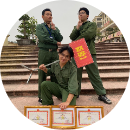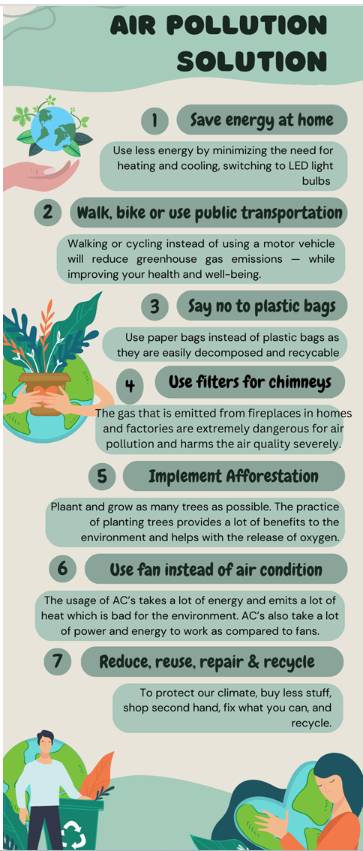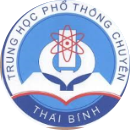Work in groups. Choose a tradition or festival in your area. Discuss ideas about how to make this tradition or festival greener.

Những câu hỏi liên quan
Work in groups. Think of a form of cultural heritage (such as a tradition, a festival, or a form of music), and discuss ways to preserve it. Report your group’s ideas to the whole class.
Our cultural heritage is a traditional craft that has been passed down from generation to generation in our community. To preserve it, we can organize workshops to teach the craft to younger generations. We can also hold exhibitions and fairs to showcase the craft to a wider audience and sell products made by local artisans. Another idea is to create a digital platform that connects artisans with customers and promotes their work.
Overall, we believe that it's important to involve younger generations in the preservation of cultural heritage and find ways to promote it to a wider audience. By doing so, we can ensure that our traditions and customs continue to thrive and evolve over time.
Đúng 1
Bình luận (0)
Our cultural heritage is a traditional craft that has been passed down from generation to generation in our community. To preserve it, we can organize workshops to teach the craft to younger generations. We can also hold exhibitions and fairs to showcase the craft to a wider audience and sell products made by local artisans. Another idea is to create a digital platform that connects artisans with customers and promotes their work.
Overall, we believe that it's important to involve younger generations in the preservation of cultural heritage and find ways to promote it to a wider audience. By doing so, we can ensure that our traditions and customs continue to thrive and evolve over time.
Tạm dịch:
Di sản văn hóa của chúng tôi là một nghề thủ công truyền thống đã được truyền từ thế hệ này sang thế hệ khác trong cộng đồng của chúng ta. Để bảo tồn nó, chúng ta có thể tổ chức các hội thảo để truyền dạy nghề cho thế hệ trẻ. Chúng ta cũng có thể tổ chức các cuộc triển lãm và hội chợ để giới thiệu nghề thủ công này cho mọi người đối tượng rộng hơn và bán các sản phẩm được làm bởi các nghệ nhân địa phương.Một ý tưởng khác là tạo ra một nền tảng kỹ thuật số kết nối các nghệ nhân với khách hàng và quảng bá công việc của họ.
Nhìn chung, chúng tôi tin rằng điều quan trọng là thu hút các thế hệ trẻ tham gia bảo tồn di sản văn hóa và tìm cách quảng bá di sản đó tới nhiều đối tượng hơn. Bằng cách đó, chúng tôi có thể đảm bảo rằng các truyền thống và phong tục của chúng tôi tiếp tục phát triển và phát triển theo thời gian.
Đúng 1
Bình luận (0)
1. Choose a custom or tradition practised in your home town.2. Search for information about that custom or tradition. You can ask your parents or grandparents about it.Use the following guiding questions:- What is the custom / tradition?- Who practises it?- Where and when do people practise it?- What do people do?- Why do people practise that custom / tradition?3. Report your findings to your class. You can use visual aids to illustrate your report.
Đọc tiếp
1. Choose a custom or tradition practised in your home town.
2. Search for information about that custom or tradition. You can ask your parents or grandparents about it.
Use the following guiding questions:
- What is the custom / tradition?- Who practises it?
- Where and when do people practise it?
- What do people do?
- Why do people practise that custom / tradition?
3. Report your findings to your class. You can use visual aids to illustrate your report.
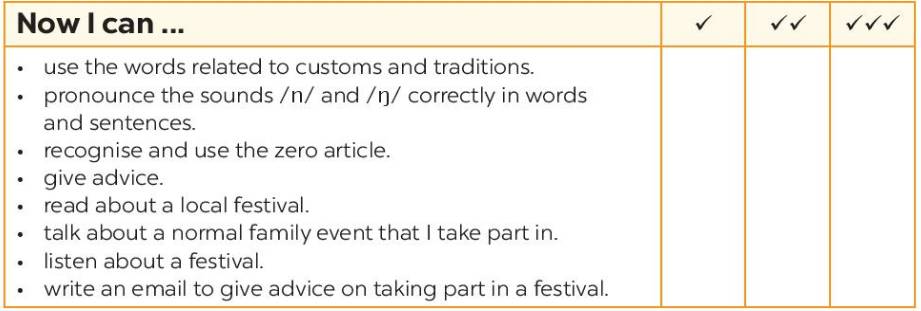
Exercise 1:
Hung Kings' Festival (Giỗ tổ Hùng Vương)
Đúng 0
Bình luận (0)
Exercise 2:
Annually, thousands of visitors from all over the country participate in a national festival – Hung King Temple Festival. It is a ceremony in honor of Hung Kings, who were instrumental in the founding of the nation. The Hung King Temple Festival is held from the 8th to the 11th day of the third lunar month, but the main festival day is on the 10th. On that day, Vietnamese working people can have a day off. The main ceremony takes place at the Hung Temple on Nghia Linh Mountain in Phu Tho Province. Many ancient and modern flags are hung along the road to the temple. During the Hung Temple Festival, there are many folk games such as bamboo swings, rice cooking competitions, human chess,… Banh Chung (square cake) and Banh Giay (circle cake) are also prepared to remind people of the Lang Lieu Legend. It’s true that the Hung King Temple Festival is one of the most important and sacred festivals of the Vietnamese people.
Tạm dịch:
Hằng năm, hàng ngàn du khách khắp đất nước tham gia vào một lễ hội toàn quốc – Lễ hội Đền Hùng. Đây là một dịp lễ tưởng nhớ các Vua Hùng, người đã có công dựng nước. Lễ Hội Đền Hùng được tổ chức từ ngày 8 đến ngày 11 tháng 3 âm lịch, những phần lễ chính sẽ diễn ra vào ngày 10, vào ngày đó thì người Việt sẽ được nghỉ làm. Phần lễ chính diễn ra tại Đền Hùng nằm trên núi Nghĩa Linh tỉnh Phú Thọ. Rất nhiều lá cờ cổ và cờ hiện đại được treo khắp dọc đường đến đề), có rất nhiều trò chơi như đánh đu, thi nấu cơm, cờ người. Bánh chưng và Bánh giày cũng được chuẩn bị để mọi người nhớ về truyền thuyết Lang Liêu. Không ngoa khi nói rằng Lễ hội Đền Hùng là lễ hội quan trọng và linh thiêng nhất của người Việt.
Đúng 0
Bình luận (0)
Exercise 3:
The Hung King Temple Festival
(Lễ hội Đền Hùng)
Introduction
King Hung Temple Festival is a traditional festival which honors the first King of Vietnam - King Hung. It's occasion for every Vietnamese to remember their origin and express their respect as well as gratitude to ancestor of Vietnamese people. Therefore, it's considered as national festival of Vietnam.
(Giới thiệu: Lễ hội Đền Hùng là một lễ hội truyền thống để tỏ lòng kính trọng đến những vị vua đầu tiên của người Việt – Vua Hùng. Đó là dịp để cho mỗi con người Việt Nam nhớ về cội nguồn của mình và bày tỏ sự tôn trọng và lòng thành kính đến tổ tiên của người Việt. Vậy nên, nó cũng được coi là một lễ hội quốc gia của Việt Nam.)
Place and time
King Hung Temple Festival takes place yearly at King Hung Temple from the 8th to 11th day of the third lunar month in the year. According to the legend, the 10th day of that month is the death anniversary of King Hung. During the festival, Vietnamese people from all over the country as well as Vietnamese people living abroad head for King Hung Temple on Nghia Linh Mountain, Phu Tho Province to take part in this historical and meaningful festival.
(Nơi tổ chức và thời gian: Lễ hội đền Hùng được tổ chức hằng năm ở Đền Hùng từ ngày 8 đến ngày 11 tháng 3 âm lịch. Theo truyền thuyết thì ngày 10 tháng đó là ngày giỗ của Vua Hùng. Vào ngày lễ thì người Việt từ khắp nơi trên thế giới cùng kiều bào hải ngoại đều hướng về Đền Hùng trên núi Nghĩa Linh để tham gia một lễ hội ý nghĩa và mang tính lịch sử này.)
The ceremony
To begin with, the spotlight is on bronze drum performance and competition of procession with participation of about 40 villages. After that, a solemn national ceremony is held with incense-offering liturgy. Governmental leaders will lead the procession up to Upper Temple (“Den Thuong”) – the highest temple of King Hung Temple Complex on Nghia Linh Mountain. Offering involves five-fruit trays, specialties from all regions in the country and indispensably a couple of “chung” cakes and “day” cakes, which are two traditional foods of Vietnam.
(Phần lễ: Đầu tiên thì điểm đáng chú ý của buổi lễ chính là phần trình diễn với trống đồng và hội rước với sự tham gia của 40 ngôi làng. Sau đó là một phần nghi lễ trang trọng được tổ chức với một đền thờ để dâng hương. Các nguyên thủ quốc gia sẽ dẫn đoàn rước kiệu lên Đền Thượng – nơi cao nhất của Khu Đền Hùng. Đồ cúng gồm mâm ngũ quả, sản vật từ khắp mọi miền đất nước và không thể thiếu một cặp bánh chưng bánh dày, hai món ăn truyền thống của người Việt.)
The festival
The festival is featured with many folk games such as “danh du” (bamboo swings), “nem con” (game of throwing a sacred ball through the ring), rice cooking competitions, lion dance, human chess, water puppet performance, wrestling, etc. All folk games contribute a bustling ambiance to the festival and attract participation of various people. Besides, “xoan” singing and “gheo” singing are also performed at the festival by local residents.
(Phần hội: Hội có rất nhiều trò chơi dân gian như đánh đu, ném còn, thi nấu cơm, múa lân, cờ người, múa rối nước, đấu vật. Tất cả các trò chơi dân gian đều mang lại một không khí nhộn nhịp và thu hút sự tham gia của rất nhiều người. Bên cạnh đó, người dân còn trình diễn những điệu hát xoan, hát ghẹo ở lễ hội.)
Conclusion
Hung King Temple Festival is not only a festival but also a special occasion where tradition embodies spiritual solidarity and provides a good time to acknowledge national origins and sources of Vietnamese cultural and moral identity.
(Lễ Hội Đền Hùng không chỉ là lễ hội mà còn là dịp đặc biệt để những phong tục truyền thống thể hiện qua tinh thần đoàn kết và có thời gian để bày tỏ lòng biết ơn về cội nguồn và nguồn gốc bản sắc văn hóa đạo đức của người Việt. )
Đúng 0
Bình luận (0)
Write a paragraph about 50 words about a festival/a custom/a tradition you know in Viet Nam or over the world
There are many festivals in Viet nam.The Hung King Temple Festival is one of the most important festivals.It takes place in Hung King Temple in Phu Tho from the 8th to the 11th day of the third lunar month. This festival is held to worship the founders of our nation.There is a big procession from the foot of Nghia Linh mountain.People offer incense and specialities such as: banh chung ,banh day and five-fruit-trays to the King ,besides,there are many traditional games and activities such as bamboo swings, lion dances,wrestling and <<Xoan>> singing performance
Đúng 0
Bình luận (3)
To honor the first king of Vietnam, Vietnamese people hold a cultural festival called the Hung King Temple festival. It takes place in Nghia Linh Mountain, Phu Tho Province every year. The Hung Temple historical area includes three main temples: Ha Temple, Trung Temple and Thuong Temple in order from the bottom of the mountain going up. People will visit and enjoy most of the activities here. During the festival, people will take part in many folk games such as bamboo swings, “nem con”, rice cooking competitions, lion dance, human chess, water puppet performance,… Besides folk games, there are also cultural festival activities, such as taking the king's litter or offering incense. It is because of these activities and competitions that the festival atmosphere becomes more noisy and crowded. The festival attracts thousands of people across the country and overseas each year. This is an occasion for every Vietnamese to express the long-lasting traditional morality “When you drink water, remember the source” when joining the festival.
Đúng 0
Bình luận (0)
Write a paragraph about 50 words about a festival/a custom/a tradition you know in Viet Nam or over the world
Imagine that your class is going to a place of interest in your area.
Work in groups to discuss the plan for this day out. Make notes in the table.
4. Work in pairs. Discuss with your partner the festival in Viet Nam that you like best. Use the word web below to take notes.
5. Now use the notes to write an article about this festival for the school website. Remember to add any necessary connectors below to make compound and complex sentences.
don't copy internet :)
2. Imagine that your class is going to a place of interest in your area.
Work in groups to discuss the plan for this day out. Make notes in the table.
Work in groups.
1. Choose a serious pollution problem in your area (noise pollution, air pollution, water pollution, ...). Suggest solutions to the problem.
2. Make a poster. Write your solutions on your poster. Use picture or illustrate / decorate your poster.
3. Present your poster to the class.

Exercise 1:
Air pollution is measured by a number called the Air Quality Index (AQI), which ranges from 0-500, with anything over 150 considered “unhealthy.” The World Health Organization considers any reading above 100 to be hazardous and recommends that people avoid prolonged exposure. While Vietnamese cities such as Hanoi and Ho Chi Minh City have AHI readings around 100 or higher, many provinces have far worse levels of pollution. In some areas of the south, where there are large rubber plantations and coal mines, AQI numbers can surpass 500.
(Ô nhiễm không khí được đo bởi một con số gọi là Chỉ số Chất lượng Không khí (AQI), có khoảng từ 0 đến 500, với bất cứ cái gì ở trên mức 150 sẽ được coi là “độc hại”. Tổ chức Y tế thế giới WHO cho rằng với mỗi lần đọc mà chỉ số trên 100 thì nghĩa là ở mức nguy hiểm và khuyến cáo mọi người tránh tiếp xúc lâu ở bên ngoài. Trong khi những thành phố ở Việt Nam như Hà Nội và thành phố Hồ Chí Minh đọc được chỉ số AHI khoảng 100 hoặc hơn, nhiều tính khác có mức độ ô nhiễm tệ hơn rất nhiều. Ở một vài vùng ở miền Nam, những vùng trồng cao su và mỏ than thì chỉ số AQI có thể vượt qua 500.)
Some simple way to reduce air pollution
(Vài cách đơn giản để giảm thiểu ô nhiễm không khí)
1. Using public transports
(Sử dụng phương tiện công cộng)
2. Turn off the lights when not in use
(Tắt điện khi không sử dụng)
3. Recycle and reuse
(Tái sử dụng và tái chế)
4. Say no to plastic bags
(Nói không với túi nhựa)
5. Reduction of forest fires and smoking
(Giảm thiểu cháy rừng và hút thuốc)
6. Use of fans instead of air conditioner
(Sử dụng quạt thay vì điều hòa)
7. Use filters for chimneys
(Sử dụng tấm lọc cho ống khói)
8. Avoid usage of crackers
(Tránh sử dụng pháo ống)
9. Avoid using of products with chemicals
(Tránh sử dụng các sản phẩm chứa nhiều chất hóa học)
10. Implement afforestation
(Tiến hành trồng rừng)
Đúng 0
Bình luận (0)
Exercise 3:
As we can know, air pollution is measured by a number called the Air Quality Index (AQI), which ranges from 0-500, with anything over 150 considered “unhealthy.” The World Health Organization considers any reading above 100 to be hazardous and recommends that people avoid prolonged exposure. While Vietnamese cities such as Hanoi and Ho Chi Minh City have AHI readings around 100 or higher, many provinces have far worse levels of pollution. In some areas of the south, where there are large rubber plantations and coal mines, AQI numbers can surpass 500. So, what can we do to improve our air quality? Here are some simple way to reduce air pollution.
The first one is saving energy at home. You can save energy by reducing the need for heating and cooling in your house and replace normal light bulb to energy saving fluorescent lights to help the environment.
The second one is using public transport or walking or riding bike whenever you can. Doing that will not only reduce the carbon emission but also help saving money. Also, walking or riding bike is good for your health.
Next is saying no to plastic bags. The use of plastic products could be very harmful to the environment as they take a very long time to decompose, due to their material made up of oil. The use of paper bags instead is a better alternative as they decompose easily and are recyclable.
Implementing afforestation is also a way to lessen air pollution. There are a lot of volunteer group plating forests every year but we can practice it at our home by plant a tree or make a garden in the yard. Trees helps release oxygen and make the atmosphere cooler.
The next one is use fan instead of air conditioner. The usage of AC’s takes a lot of energy and emits a lot of heat which is bad for the environment. AC’s also take a lot of power and energy to work as compared to fans.
Finally, we reduce, reuse, repair and recycle. We should buy less stuff and buy second hand, fix what you can and recycle. This helps save a lot of money and protect the environment.
Tạm dịch:
Như chúng ta đã biết, ô nhiễm không khí được đo bởi một con số gọi là Chỉ số Chất lượng Không khí (AQI), có khoảng từ 0 đến 500, với bất cứ cái gì ở trên mức 150 sẽ được coi là “độc hại”. Tổ chức Y tế thế giới WHO cho rằng với mỗi lần đọc mà chỉ số trên 100 thì nghĩa là ở mức nguy hiểm và khuyến cáo mọi người tránh tiếp xúc lâu ở bên ngoài.
Trong khi những thành phố ở Việt Nam như Hà Nội và thành phố Hồ Chí Minh đọc được chỉ số AHI khoảng 100 hoặc hơn, nhiều tính khác có mức độ ô nhiễm tệ hơn rất nhiều. Ở một vài vùng ở miền Nam, những vùng trồng cao su và mỏ than thì chỉ số AQI có thể vượt qua 500. Đây là vài cách đơn giản để giảm thiểu ô nhiễm không khí.
Đầu tiên là tiết kiệm điện ở nhà. Bạn có thể tiết kiệm năng lượng bằng cách giảm nhu cầu sưởi ấm và làm mát trong nhà và thay bóng đèn thường thành đèn huỳnh quang tiết kiệm năng lượng để bảo vệ môi trường. Thứ hai là đi phương tiện công cộng hoặc đi bộ hay đạp xe bất cứ khi nào có thể. Thực hiện việc đó có thể làm giảm khí thải cacbon mà còn tiết kiệm tiền. Đi bộ và đạp xe cũng giúp cải thiện sức khỏe. Thứ ba là nói không với túi ni-lông. Việc sử dụng túi ni lông rất có hại cho môi trường vì chúng rất khó phân hủy, do nhựa được làm từ dầu mỏ. Sử dụng túi giấy là một biện pháp thay thế tốt vì dễ phân hủy và có thể tái chế. Trồng rừng cũng là một cách để giảm ô nhiễm không khí. Hằng năm có rất nhiều nhóm tình nguyên tham gia trồng rừng nhưng chúng ta có thể thực hiện ở nhà bằng cách trồng cây hoặc làm một khu vườn. Cây cối giúp tạo ra oxi và giúp bầu không khí trở nên mát mẻ hơn. Tiếp theo là sử dụng quạt thay vì dùng điều hòa. Sử dụng điều hòa tốn nhiều năng lượng hơn và tỏa ra nhiều nhiệt, điều này có hại cho môi trường. So với quạt thì điều hòa cần rất nhiều năng lượng để hoạt động. Cuối cùng là giảm thiểu, tái sử dụng, sửa chữa và tái chế. Chúng ta nên mua ít đồ hơn, mua đồ xách tay, sửa chữa những gì có thể và tái chế. Điều này giúp tiết kiệm tiền và bảo vệ môi trường.
Đúng 0
Bình luận (0)
Work in pairs. Prepare to do the task in exercise 3.
- Choose three activities that you would like to do using the list in exercise 1 or your own ideas. Make sure you and your partner choose different activities.
- Make notes about:
a. why you want to do the activities you have chosen.
b. why you do not want to do the activities your partner has chosen.
My three activities: surfing, climbing, kayaking
(Ba hoạt động của tôi: lướt sóng, leo núi, chèo thuyền kayak)
My partner’s three activities: hiking, hang-gliding, mountain biking
(Ba hoạt động của đối tác của tôi: đi bộ đường dài, đi tàu lượn, đạp xe leo núi)
a. why you want to do the activities you have chosen.
(tại sao bạn muốn thực hiện các hoạt động bạn đã chọn.)
- suitable location.
(vị trí phù hợp.)
- enjoy new feelings on the water.
(tận hưởng cảm giác mới lạ trên mặt nước.)
- beautiful view on the top of a mountain.
(góc ngắm cảnh đẹp trên đỉnh núi.)
b. why you do not want to do the activities your partner has chosen.
(tại sao bạn không muốn thực hiện các hoạt động mà đối tác của bạn đã chọn.)
- have to walk long distances.
(phải đi bộ đường dài.)
- have to buy special equipment.
(phải mua thiết bị đặc biệt.)
- it’s tiring.
(nó mệt mỏi.)
Đúng 0
Bình luận (0)
Restore and protect a local ecosystemWork in groups. Make a poster to illustrate an ecosystem in your local area and suggest ideas to restore and/or protect it.Give a group presentation. Use these questions as cues. - What does the ecosystem include?- What is its current condition? Is it damaged?- What can we do to restore and/or protect it?
Đọc tiếp
Restore and protect a local ecosystem
Work in groups. Make a poster to illustrate an ecosystem in your local area and suggest ideas to restore and/or protect it.
Give a group presentation. Use these questions as cues.
- What does the ecosystem include?
- What is its current condition? Is it damaged?
- What can we do to restore and/or protect it?
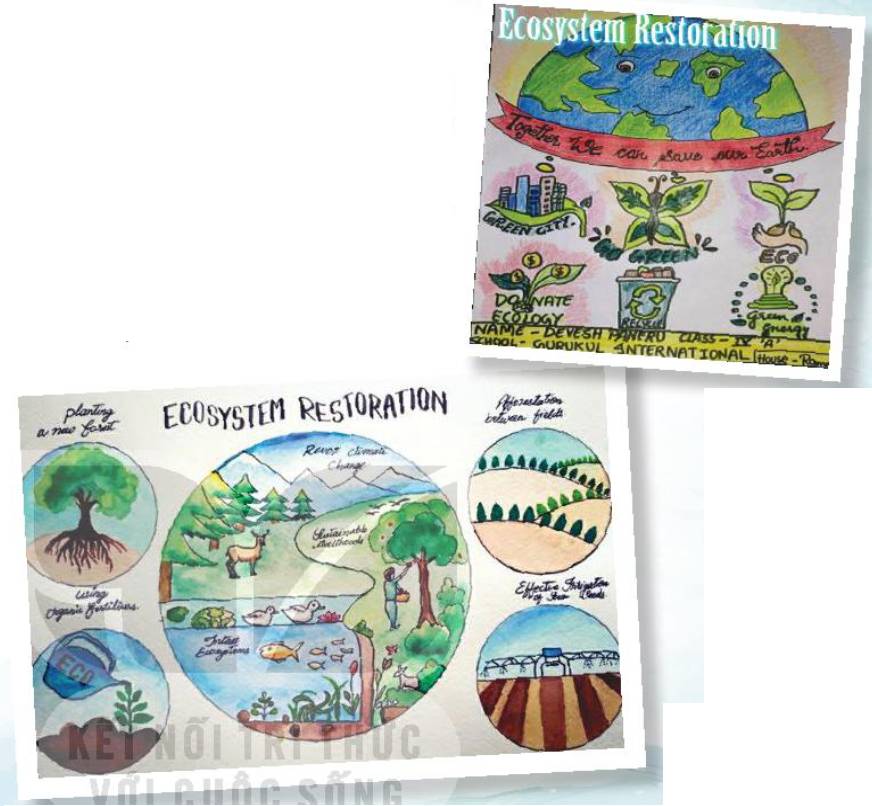
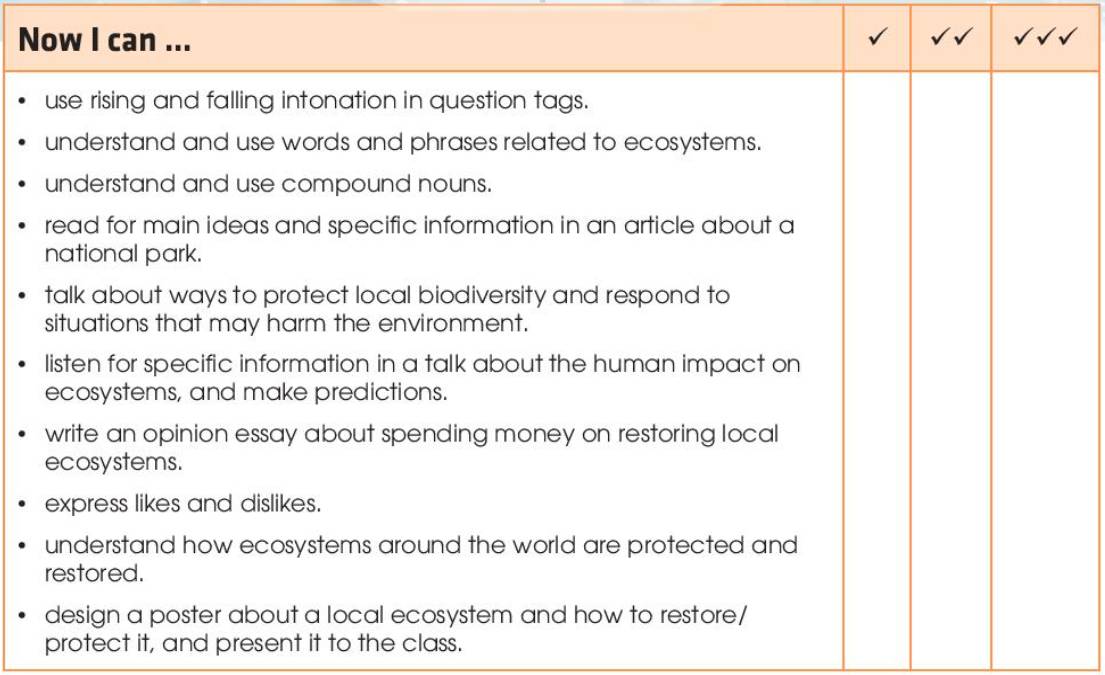
Tham khảo:
Hanoi – the capital of Vietnam, is not only a place with a developed economy but also an ideal tourist destination. For a long time, Hanoi is famous for 36 ancient streets. Each street is famous for a different typical craft village. Coming to Hanoi capital, we cannot ignore attractive tourist destinations such as Hoan Kiem Lake, Quoc Tu Giam Temple, Ho Chi Minh Mausoleum, or Bat Trang Pottery Village, … I was attracted to the unforgettable specialties of Hanoi such as Trang Tien ice cream, Vong village nuggets, Ho Tay shrimp cakes, … Hanoi people are very friendly and open. They are always happy to show the visitors the way. Not only that, the people of Hanoi are also very industrious and hard-working. To me, Hanoi is a beautiful, poetic, and well worth living city. But now, Hanoi's ecosystem is seriously affected by human impacts. Therefore, we need to take some of the following measures to protect and restore the ecosystem:
Try to reduce the amount of non-biodegradable or recycle waste.
oin as many tree planting trips and plant trees as more as you can. Trees absorb carbon dioxide – a greenhouse gas.
Use compact fluorescent light bulbs: they may be more expensive, but they can be used longer, the more money you can save, the more money paid on the electric bill is reduced.
Turn off your devices, and save energy to protect the environment: Switching off all electric things when they are not in use.
Use recycled paper to save trees.
Here are some ways to protect the ecosystem in Hanoi. Above all, we all need to be conscious of protecting the local ecosystem.
Đúng 4
Bình luận (4)








